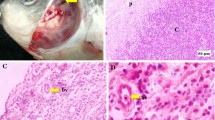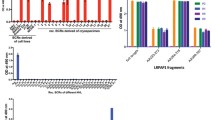Summary
The CD21 antigen has been described to represent CR2, the receptor for the complement fragment C3d and also the receptor for the Epstein-Barr virus (EBV). Monoclonal antibodies B2, HB5, and B-ly4 belong to the CD21 cluster, recognizing different epitopes of the CD21-molecule. Immunohistology of lymphoid tissues employing these antibodies showed the known staining of B cells and dendritic reticulum cells. Surprisingly, B2, but not HB5 or B-ly4, stained a distinct spot in the cytoplasm of a major proportion of medullary thymocytes, in almost all peripheral blood lymphocytes, and in a substantial amount of cells in T-cell areas of peripheral lymphoid tissues. This distinct cytoplasmic B2 staining was confirmed by immuno-electronmicroscopy. A similar B2+ cytoplasmic dot was observed in B-lymphoblastic lymphomas. Staining of non-lymphoid tissues showed reactivity with all three CD21 mAb with epithelial cells of skin, lung, esophagus, jejunum, colon, pancreas, tonsil, adrenal cortex, renal tubuli, and parotid glands, and with hepatocytes and tongue muscle. In addition, endothelial cells of small vessels showed B2 staining. One possible explanation for our results is, that apart from the presence of B cells and follicular dendritic cells, a CD21-molecule may be expressed by other cell types. However, a maybe more likely explanation may be that the recognized epitopes are not exclusively associated with the C3d/EBV-receptor, but also with other structures. In particular should the possibility be recognized of cross-reactivity with CR2-related proteins, encoded by the large gene family, to which CR2 belongs.
Similar content being viewed by others
References
Ahearn JM, Fearon DT (1989) Structure and function of the complement receptors, CR1 (CD35) and CR2 (CD21). Adv Immunol 46:183–219
Cooper NR, Moore MD, Nemerow GR (1988) Immunobiology of CR2, the B lymphocyte receptor for Epstein-Barr virus and the C3d complement fragment. Ann Rev Immunol 6:85–113
Fearon DT (1984) Cellular receptors for fragments of the third component of complement. Immunol Today 5:105–110
Fingeroth JD, Weiss JJ, Tedder TF, Strominger JL, Biro PA, Fearon DT (1984) Epstein-Barr virus receptor of human B-lymphocytes is the C3d receptor CR2. Proc Natl Acad Sci USA 81:4510–4514
Foon KA, Schroff RW, Gale RP (1982) Surface markers to leukemia and lymphoma cells: recent advances. Blood 60:1–19
Frade R, Barel M, Ehlin-Hendriksson B, Klein G (1985) gp140, the C3d receptor of human b-lymphocytes, is also the Epstein-Barr virus receptor. Proc Natl Acad Sci USA 82:1490–1493
Gerdes J, Hansmann ML, Stein H, Naiem M, Mason DY (1982) Ultrastructural localization of human complement C3b receptors in the human kidney as determined by immunoperoxidase staining with the monoclonal antibody C3RT05. Virchows Arch B 40:1–7
Graham RL, Lundholm U, Karnovsky MJ (1965) Cytochemical demonstration of peroxidase reactivity with 3-amino-9-ethylcarbazole. J Histochem Cytochem 13:150–152
Hopf U, Meyer zum Büschenfelde KH, Dierich MP (1976) Demonstration of binding sites for IgG, Fc, and the third complement component (C3) on isolated hepatocytes. J Immunol 117:639–645
Knapp W, Dörken B, Gilks WR, Rieber EP, Schmidt RE, Stein H, Von dem Borne AEGKr (1989) Leucocyte typing IV. White cell differentiation antigens. Oxford Unviersity Press, Oxford, New York, Tokyo
Mason DY, Woolston RE (1982) Double immuno-enzymatic labelling. In: Bullock GR, Petrusz P (eds) Techniques in immunocytochemistry. Academic Press, New York, pp 140
McLean IW, Nakane PK (1974) Periodate-lysine paraformaldehyde fixative: a new fixative for immunoelectronmicroscopy. J Histochem Cytochem 22:1077–1083
Nadler LM, Stashenko P, Hardy R, Van Agthoven A, Terhorst C, Schlossman SF (1981) Characterization of a human B-cell specific antigen (B2) distinct from B1. J Immunol 126:1941–1947
Reynes M, Aubert JP, Cohen JHM, Andouin J, Tricottet V, Diebold J, Kazatchkine MD (1986) Human follicular dendritic cells express CR1, CR2, and CR3 complement receptor antigens. J Immunol 135:2687–2694
Ryan US, Schultz DR, Ryan JW (1981) Fc and C3b receptor on pulmonary endothelial cells: induction by injury. Science 214:557–558
Schenkein H, Genco RJ (1979) Inhibition of lymphocyte blastogenesis by C3c and C3d. J Immunol 122:1126–1133
Sixbey JW, Davis DS, Young LS, Hutt-Fletcher L, Tedder TF, Rickinson AB (1987) Human epithelial cell expression of an Epstein-Barr virus receptor. J Gen Virol 68:805–811
Stashenko P, Nadler LM, Hardy R, Schlossman SF (1981) Expression of cell surface markers after human B-lymphocyte activation. Proc Natl Acad Sci USA 78:3848–3852
Tedder TF, Clement LT, Cooper MD (1984) Expression of C3d receptors during human B cell differentiation: immunofluorescence analysis with the HB-5 monoclonal antibody. J Immunol 133:678–683
Timens W, Poppema S (1985) Lymphocyte compartments in human spleen. An immunohistologic study in normal spleens and non-involved spleens in Hodgkin's disease. Am J Pathol 120:443–454
Vik DP, Fearon DF (1986) Cellular distribution of complement receptor type 4 (CR4): expression on human platelets. J Immunol 138:254–258
Weiss JJ, Tedder TF, Fearon DT (1984) Identification of a 145.000 Mr membrane protein as the C3d receptor (CR2) of human B-lymphocytes. Proc Natl Acad Sci USA 81:881–885
Wolff H, Hausen H zur, Becker V (1973) EB viral genomes in epithelial nasopharyngeal carcinoma cells. Nature 244:245–247
Young LS, Clark D, Sixbey JW, Rickinson AB (1986) Epstein-Barr virus receptors on human pharyngeal epithelia. Lancet I:240–241
Young LS, Dawson CW, Brown KW, Rickinson AB (1989) Identification of a human epithelial cell surface protein sharing an epitope with the C3d/Epstein-Barr virus receptor molecule of B lymphocytes. Int J Cancer 43:786–794
Author information
Authors and Affiliations
Rights and permissions
About this article
Cite this article
Timens, W., Boes, A., Vos, H. et al. Tissue distribution of the C3d/EBV-receptor: CD21 monoclonal antibodies reactive with a variety of epithelial cells, medullary thymocytes, and peripheral T-cells. Histochemistry 95, 605–611 (1991). https://doi.org/10.1007/BF00266748
Accepted:
Issue Date:
DOI: https://doi.org/10.1007/BF00266748




